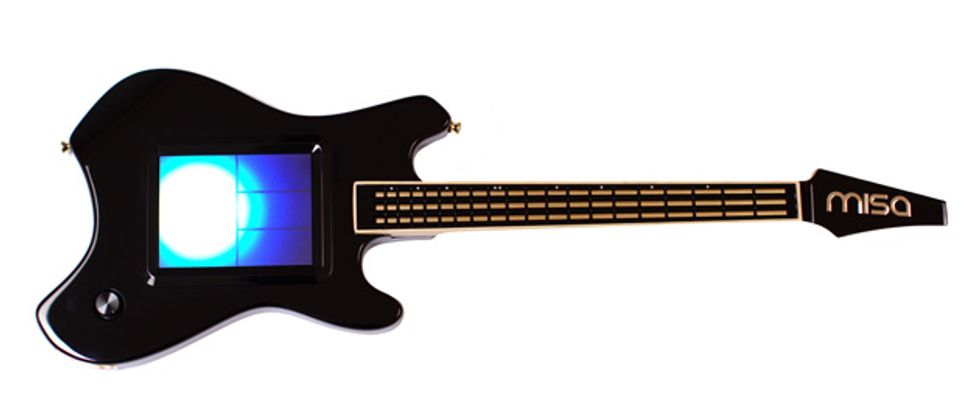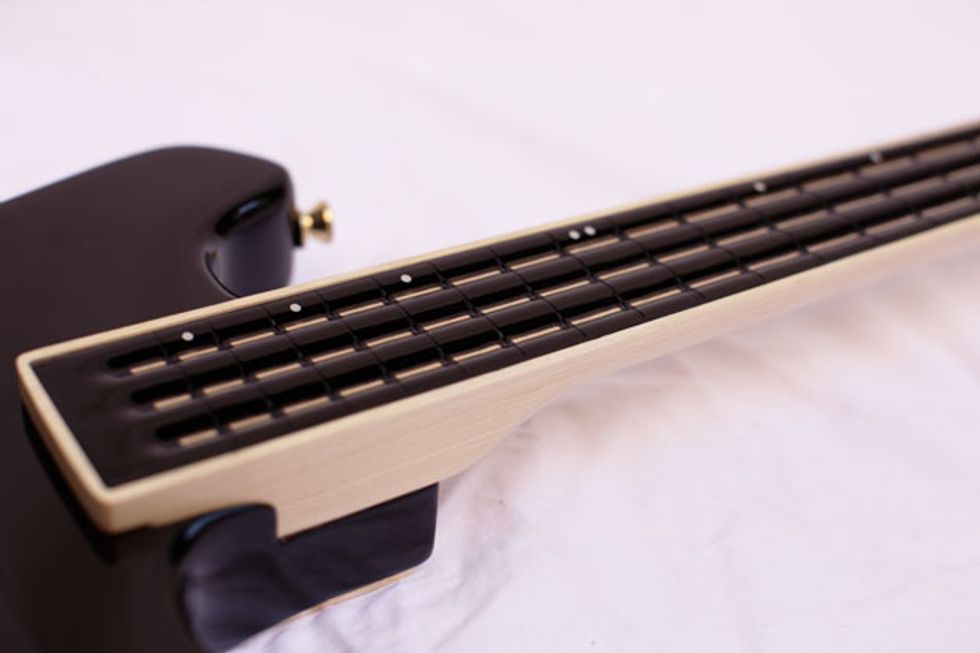When it comes to exploring innovation in the bass realm, how far are you willing to go?
Fig. 1. Featuring a late-’60s body shape, the Misa Tri-Bass is actually a MIDI controller that’s triggered by a touchpad.
If there’s anything that obviously marks a bass as futuristic, it’s the instrument’s shape or overall look. I’m sure the Stash Stainless Bass we saw last month perfectly fits this category [“The Future of Bass,” February 2014].
The last decades have brought basses with some very experimental shapes, but none of them really made an impression with the masses. The Precision and Jazz bass—along with countless “inspired by” instruments—are still the top sellers, and in all these years the only real game changer was Ned Steinberger’s headless design.
Anything else? Maybe the first MIDI-equipped basses or moving from the 4-string to the 5-string and beyond. Of course, there have always been minor developments here and there, but not the kind of evolutionary shift we’re talking about.
As bassists, it appears we’re a very frugal herd, yet the No. 1 customer question at any trade show is “What’s new?” At almost every music fair, a few idealistic young people show up with their new ideas. Most optimistically invest all their money and time to bring something to the market that—in their vision—will be a game changer. Some are simply naive, but others definitely deserve more attention.
For example, in 2010 I saw a young Japanese musician demonstrate his invention, the ViolaFon. Essentially, it was a guitar with a violin-shaped body and a very small radius fretboard that allowed him to play with a bow. His demo marathons ran about eight hours a day, and no doubt he spent most of his money on the trip, hotel, and booth. He managed to score mass-media coverage, yet his invention was presented as a curiosity, something to entertain us while we examined that year’s twists on traditional designs.
Bass players are widely regarded as open-minded, yet our adoption rate for truly new ideas is close to zero. That’s why the No. 1 answer to the No. 1 trade show question is often: “Why do you ask? You wouldn’t buy it anyway.”
Typically, the reason innovators show up at trade shows is that from the outside, our gear looks pretty outdated. To the inventor, it seems obvious that innovation would be welcomed in our world. At first glance, this seems to be a correct assessment.
For instance, most of us still use cables, while everything else around us is now wireless. And we still deal with the huge old mono plugs and their tiny contact areas. We don’t even dare to use XLR cables, which could provide phantom power for all our active circuitry. Grab your singer’s microphone cable and you’re almost ready to go. Of course, “almost” means “once the rest of the equipment is updated.”
So on second look, we’d risk ending up with another trunk of adapters and incompatible gear. Better not go there.
Putting aside electronics, one could think of ease-of-operation or improved ergonomics as a field worth exploring. But this can be difficult, as we partially discussed in “The Ergonomic Bass” [February 2013].
Why? Ergonomic design is very personal. The most commonly requested feature is a lightweight bass, but there could and should be more. What about new strap systems or moveable “self-fitting” parts?
Fig. 2. Sporting ribbon controllers instead of strings, this is light-years away from your standard fretboard. Photos courtesy of Misa Digital (misadigital.com)
Most bass players prefer a higher-strapped position of their instrument for slap style, yet hang it lower for fingerstyle technique. This means that the way we actually adjust straps is often just a compromise. Just like a car seat can memorize and automatically adjust to different positions, couldn’t there be a system that also readjusts the strap length? Sounds comfy, right?
And when we dial in the tone for a specific style, we memorize the previous technical outcome of “turn that knob this far to reduce mids” instead of having a programmable button labeled “Slap.”
I recall my own experiences with the first programmable, MIDI-equipped amps as a lost year for my musical progress. It’s as if the limited possibilities of our current instruments can help keep our focus where it belongs: on music.
So for most players, progress means a slight integration of new with the familiar. In other words, “Let’s keep it old-school with a tiny grain of innovation.”
One extreme example of new mixed with old is the Misa Tri-Bass (Fig. 1). Its shape resembles the Fender Swinger guitar, which dates back to 1969. Despite the word “bass” in the model name, the Misa is really a MIDI controller that doesn’t produce any sounds on its own. The three ribbon controllers on the “fretboard” (Fig. 2) simulate the feel of a 3-string bass. Pressing one of the four regions on the touchpad will trigger a sound on an external synth that can be altered by moving around on the screen.
So as opposed to the Stash bass—which offers a futuristic shape and unusual materials, yet keeps all the things you’d expect from a bass—the Tri-Bass does just the opposite: It retains an old-style look of a bass, while totally dismissing all things classically related to bass playing. Such as strings. It’s very extreme and takes us far away from what we’re used to ... at least for now.




